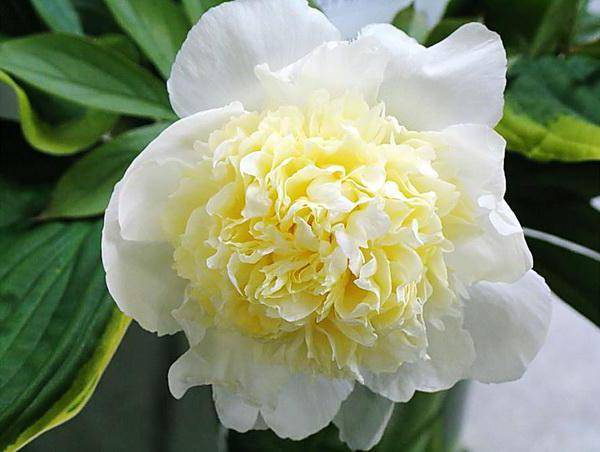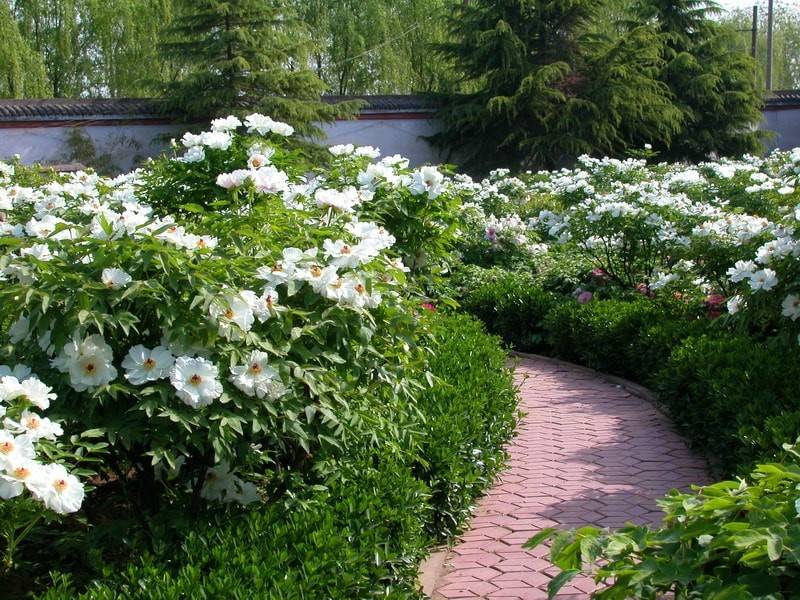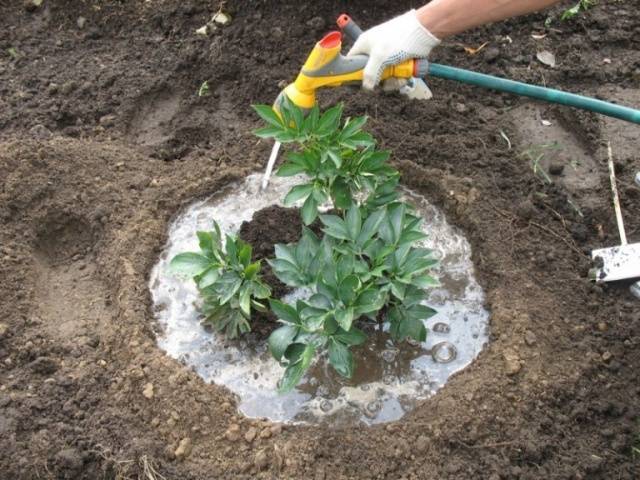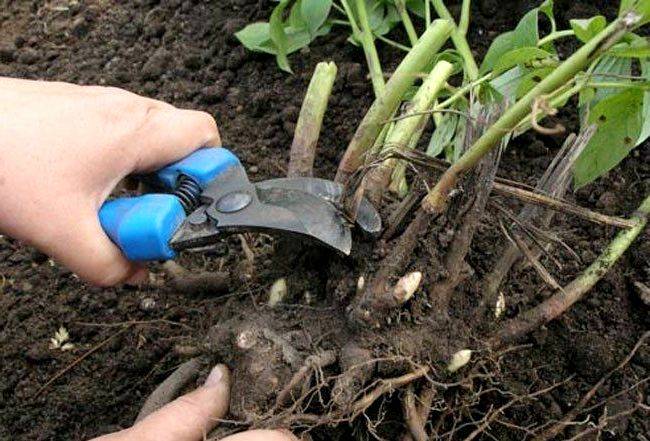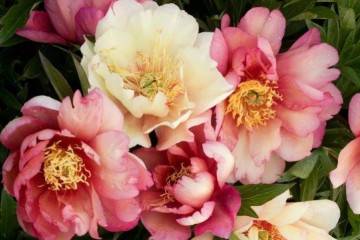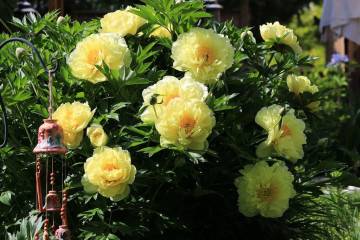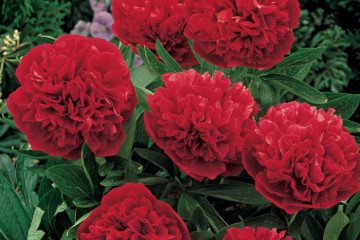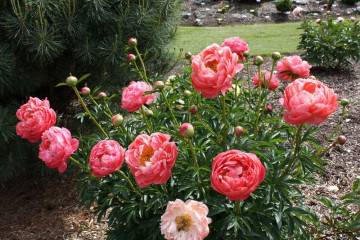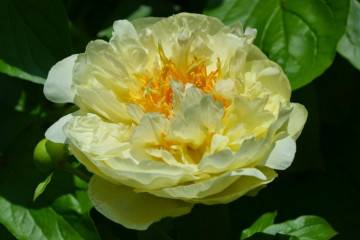Peony Primavera (Paeonia Primevere) - characteristics of the variety
Content:
The Primavera peony is an attractive herbaceous plant. The flower is versatile and can grow in different climates. To succeed in growing a crop, she needs to provide quality care.
Peony Primavera (Paeonia Primevere) - what is this variety, history of creation
The culture was bred back in 1907. This was done by French breeders. Since then, the flower has become widespread throughout the world.
Brief description, characteristic
Culture has many benefits. The Primevere peony has powerful, fleshy roots. Strong stems are characteristic of it, so that the plant can not be tied up.
Numerous descriptions of the Primavera peony indicate that the culture has large inflorescences. They reach 18 cm in diameter. Flowers can be pink or cream. They have a darker center.
The petals of the primavera herbaceous peony inflorescences are distinguished by a double texture. The foliage is large and shiny in texture. The plant perfectly tolerates any climatic conditions. It is able to withstand frost and has a strong immunity to disease.
Advantages and disadvantages of the variety
Paeonia Primavera has many benefits:
- high decorativeness;
- lush and abundant flowering;
- convenience for decorating flower beds;
- high frost resistance;
- unpretentious care.
At the same time, the plant also has certain disadvantages. For example, it can suffer from diseases and pests. If the planting work is carried out incorrectly, there is a risk of lack of flowering.
Use in landscape design
This perennial plant is actively used in landscape design. Primavere lacto-flowered peony can be used to decorate flower beds, borders and other compositions. The plant is tall, so it is permissible to use it to create a hedge.
Growing a flower, how to plant it in open ground
To get a strong plant with stable decorative properties, it is necessary to carry out planting work correctly.
Planting by root cuttings
Most often, the plant is propagated by root cuttings. You can buy them in the store or prepare them yourself. In the second case, the bush must be dug up and the rhizome divided into fragments. This should be done with a sharp knife. Prepared parts of the roots can be planted in the ground.
What time is the boarding
In order for the plant to better adapt to new conditions, planting work should be carried out in early autumn. This ensures the full development of the root system and allows the buds to be set for future flowering.
Location selection
The culture is recommended to be planted in well-lit areas. It is important that they are protected from draft and wind.
How to prepare the soil and flower for planting
Before planting, you need to make a depression 60 cm in size. The distance between the plants should be 70 cm. 10-12 kg of humus and 200 g of superphosphate and a potassium mixture should be added to the hole.
Planting procedure step by step
To plant a peony, you need to do the following:
- Organize a drainage layer in the depression.
- Sprinkle it with nutrient mixture.
- Place a bush in the hole and smooth out its roots.
- Sprinkle with earth and tamp.
- Drizzle with warm water.
- Cover the bed with mulch.
Seed planting
Peonies are rarely propagated by seed. The fact is that this method is laborious and is considered not very effective. Usually it is used by breeders to obtain new varieties of crops.
Plant care
In order for the plant to fully grow and bloom profusely, it must be well looked after.
Watering and feeding
Peonies need to be watered several times a week. Pour 1-2 buckets of water under 1 bush. If the soil dries out quickly, the amount of watering should be increased.
When planting peonies in fertile soil, you need to feed them from 3 years of age. For this, it is permissible to use humus. Special complex formulations are also suitable.
Mulching and loosening
To avoid moisture loss and stop the development of weeds, the soil must be mulched. For this, hay, dry grass, sawdust are used.
Timely loosening of the soil is of no small importance. This procedure should be carried out after watering or rainfall.
Preventive treatment
The plant can periodically encounter dangerous pathologies. To avoid such problems, it is worth carrying out preventive treatments. For this, drugs such as Hom, Forecast, Topaz are used.
Blooming peony Primavera
The culture is highly decorative and blooms profusely. In order for flowering to last as long as possible, it is necessary to clearly carry out agrotechnical measures.
A period of activity and rest
The peony begins to bloom in the first half of summer. During this period, the bushes are decorated with lush terry inflorescences. With the arrival of cold weather, the culture begins a period of rest.
Care during and after flowering
In order for the peony to fully develop and bloom as long as possible, you need to establish a watering regime. It is also worth fertilizing correctly. They are used at the stage of bud formation, during flowering and after its end.
What to do if it does not bloom, possible reasons
In order to achieve the formation of buds, the peony needs to provide sufficient light. If you plant a bush in the shade, the plant will be lush and branched. At the same time, it will not be able to bloom. Also, this problem often occurs when the planting is too deep or too shallow.
Peonies after flowering
After the end of the flowering period, peonies continue to develop. During this period, the active formation of the kidneys occurs. They can be used for culture propagation.
Transfer
Peony grows well in one place for about 20 years. Therefore, you can not transplant it. But if necessary, bushes older than 6-7 years can be propagated by division. This procedure should be combined with moving to a new site.
It is necessary to divide the bush at the beginning of autumn.It is not recommended to postpone this procedure. Otherwise, the planted fragments will not have time to take root, which will lead to their death.
Pruning
After the end of flowering, it is recommended to cut off all peduncles and dry leaves. Peony stems are removed in early October.
Preparing for winter
It is recommended to cover young plants with sawdust or spruce branches. You can also put boxes of straw over them. With the arrival of spring, the insulation must be removed immediately. Otherwise, there is a risk of disruption in the development of shoots, which will lead to the death of the plant.
Diseases, pests and ways to control them
A peony of this variety can suffer from such problems:
- Gray mold - This is a fungal infection that damages the roots. This disease is associated with waterlogging of the soil. Hom or copper sulfate will help to cope with it.
- Powdery mildew - occurs in conditions of high humidity. In this case, the leaves and shoots are covered with a white bloom. Topaz or Fitosporin will help to cope with the problem.
- Aphids - in this case, the bushes are covered with small black dots. The parasites cause the leaves to roll. The drugs Actellik or Fitoverm will help to destroy them.
Peonies have excellent decorative properties and are often used to decorate flower beds. Primavera is considered one of the most popular varieties. To achieve success in its cultivation, you need to strictly follow the recommendations of specialists.
